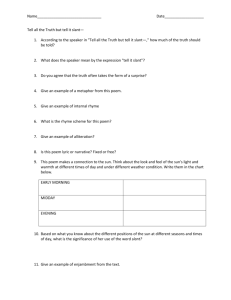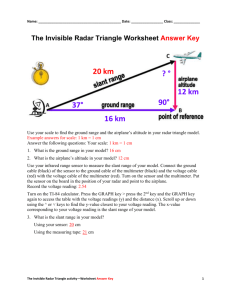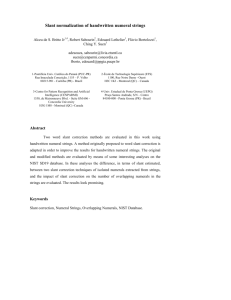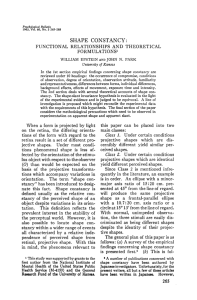SLANT – Handout 2 GRADE 8 LESSON 22 ACTIVE LISTENING 3.8
advertisement
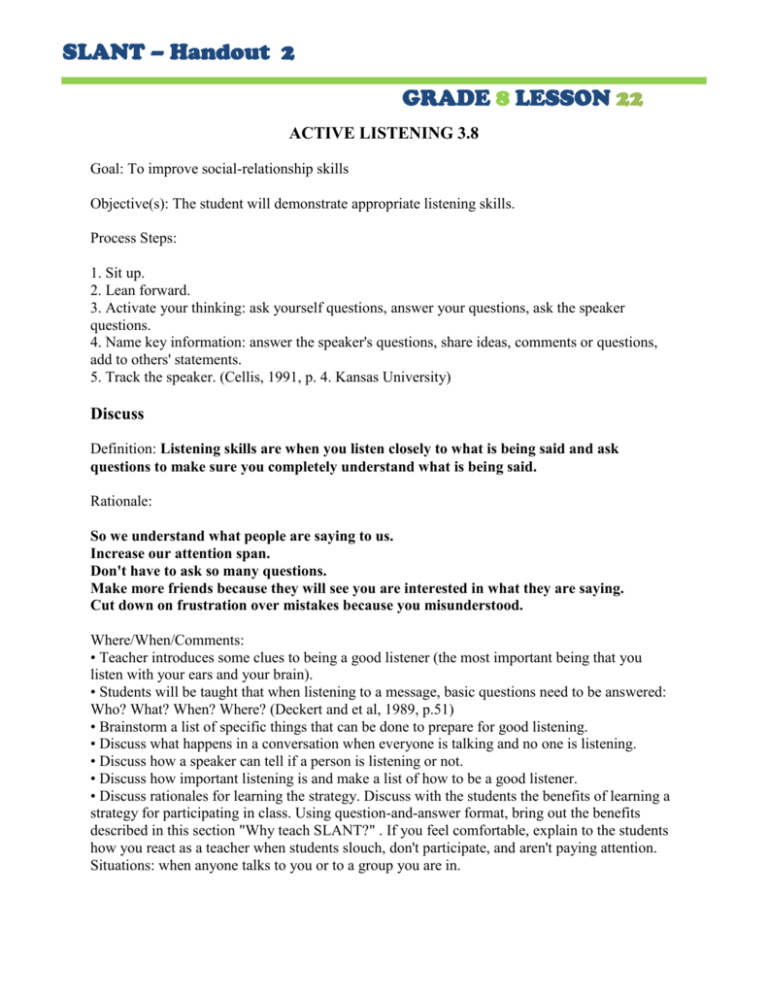
SLANT – Handout 2 GRADE 8 LESSON 22 ACTIVE LISTENING 3.8 Goal: To improve social-relationship skills Objective(s): The student will demonstrate appropriate listening skills. Process Steps: 1. Sit up. 2. Lean forward. 3. Activate your thinking: ask yourself questions, answer your questions, ask the speaker questions. 4. Name key information: answer the speaker's questions, share ideas, comments or questions, add to others' statements. 5. Track the speaker. (Cellis, 1991, p. 4. Kansas University) Discuss Definition: Listening skills are when you listen closely to what is being said and ask questions to make sure you completely understand what is being said. Rationale: So we understand what people are saying to us. Increase our attention span. Don't have to ask so many questions. Make more friends because they will see you are interested in what they are saying. Cut down on frustration over mistakes because you misunderstood. Where/When/Comments: • Teacher introduces some clues to being a good listener (the most important being that you listen with your ears and your brain). • Students will be taught that when listening to a message, basic questions need to be answered: Who? What? When? Where? (Deckert and et al, 1989, p.51) • Brainstorm a list of specific things that can be done to prepare for good listening. • Discuss what happens in a conversation when everyone is talking and no one is listening. • Discuss how a speaker can tell if a person is listening or not. • Discuss how important listening is and make a list of how to be a good listener. • Discuss rationales for learning the strategy. Discuss with the students the benefits of learning a strategy for participating in class. Using question-and-answer format, bring out the benefits described in this section "Why teach SLANT?" . If you feel comfortable, explain to the students how you react as a teacher when students slouch, don't participate, and aren't paying attention. Situations: when anyone talks to you or to a group you are in. • Discuss when and where to use the strategy. Specify how using the strategy in your classroom will facilitate success. Then ask the students to: • Identify other classes where the strategy can be used to facilitate success; and • Identify situations and settings outside school where the strategy can be used. Describe the strategy steps. Explain that there are five steps in the strategy and each step can be used to cue certain behaviors. Then name each step and the behaviors each step is designed to cue. Provide examples and non-examples of behaviors that fulfill each step. When you get to the "A" and "N" steps, explain the rules for asking questions or volunteering to participate in your classroom (e.g., you must raise your hand, quietly wait to be called on by name, lower your hand when someone else is called on, etc.). Explain that these rules may be different for different teachers, and ask your students if other teachers' rules are different from yours. (Slant, p.3) Set the Stage: • Provide many auditory and casual distractions (radio, fan, movie, etc.). Give complex directions quietly then ask students to carry out. Discuss why listening is important. Model/Role-play with Feedback • Demonstrate the strategy. Make your demonstration fun and entertaining through the use of two hats: a "teacher" hat and a "student" hat. Wear the "teacher" hat when you are acting as the teacher; put the "student" hat on when you are acting as the student. Explain the two hats to your students. Start the activity as the student and pretend that you are at the beginning of class. Slouch in your chair. Then stand up, put on your teacher hat, and state that it's time for class to get started. Put on your student hat, sit down and talk to yourself aloud to instruct yourself to use the SLANT Strategy (e.g., "Okay, I need to get started with SLANT. "S" means sit up straight." (Sit up straight.) "L" means lean forward." (lean forward.) Switch hats again, stand up, and introduce the lesson. Switch hats again, sit down and activate your mind about the lesson. Feel free to act a little silly, joke, or do other things to make the demonstration fun while at the same time illustrating the key behaviors associated with using the strategy. Be sure to demonstrate asking yourself questions, answering those questions, determining that you don't understand something, and asking a question. Also demonstrate answering a question and tracking the teacher. Continue thinking out loud as you demonstrate these behaviors. (An alternative activity here would be having your team teacher, a paraprofessional, or a student aide act as the teacher while you act as the student.) (SLANT, p.4) • Students can point to objects and pictures named by teacher. • Students can follow directions given by the teacher. • Students can listen to sounds in the environment and name them. • Students can listen to short stories and answer the basic questions." • Barrier games. • "Hot and Cold" game. • "Treasure Hunt" - following verbal directions. • "Simon Says". Role play situations: • You listen to teacher explain assignment. • You listen to parent tell you why she's sad. • You listen as a friend tells you about a movie. • Younger sibling wants to talk to you about problems with a friend. • You are talking to your friends. Announcements start coming over the intercom. Application with Feedback • The general practice sequence. Essentially, all of the practice activities involve students practicing and evaluating the use of SLANT during a traditional instructional lesson (a social studies lesson, a science lesson, a strategy lesson) that you present. You can follow this general sequence: • Provide an advance organizer for the day's lesson; • Help students set goals for SLANT performance; • Teach traditional lesson as students practice the SLANT Strategy; and • End the sequence with a feedback session. • The "UNSLANT-SLANT" activity. A fun way to begin practicing the SLANT. Strategy is to ask students to "UNSLANT" on signal. Encourage students to get their worst "UNSLANT" positions (slouched in their chairs, a far-away, blank look in their eyes, looking out the windows, etc.) immediately after you give the "UNSLANT" signal, and then switch to the SLANT position at the next signal. You might say something like, "O.K., now SLANT!" This UNSLANT-SLANT activity might be repeated once or twice the first time it is introduced. Later, surprise your students by saying, "Everybody UNSLANT. O.K., now everybody SLANT." The activity requires about 30 seconds, and the rejuvenating effects it can have on students can be very beneficial. Have students give directions for doing the following: • wrapping a package • peeling potatoes • buying shoes • eating the following: caramel, ice cube, a juicy orange • walking on the following: wet grapes, a sticky floor, eggs (St. Louis Public Schools, 1990, p.151) • Put students into pairs. Blind fold one student and assign a task to be completed by the pair (wash the table, get a drink, make a drink, get supplies, walk somewhere). • The "SLANT teams" activity (Version 1). Divide your class into cooperative learning teams of four students each. Assign each member of a team responsibility for observing another member of the same team during the upcoming lesson. Thus, each team member is a "peer- observer" and evaluates another student's use of the SLANT behaviors. Groups can be told that the activity is designed to perfect their use of SLANT before competition with other groups begins. Students can use simple charts to record their observations during two or three specified 5-minute periods during the lesson. Following the lesson, the teams can reconvene to provide each of the members with feedback on their use of SLANT. Note: At times, you may encounter the problem of having students volunteering to participate in a disruptive manner. If this occurs, consider setting a cap on the maximum number of times a student can participate in the lesson. Also, remind the students about your rules concerning courteously waiting to be called upon and listening to others' contributions. State that you will not call on students who try to get your attention by waving their arms, calling out to you, etc. • The "SLANT teams" activity (Version 2). In this version, cooperative learning groups compete with each other for the highest SLANT score. To implement the procedure, select one member of each group to be observed by a peer-observer from another group. Inform peer-observers only of the identity of the one person they are to observe. Thus, none of the other students should know whether they have been chosen to be observed. Again, the peer- observers can use simple charts and the point system for awarding and recording points. At the end of class, the points can be totaled, and everyone in the targeted student's group can receive the same the number of points for participating in the lesson. The group with the highest score can be congratulated. • The "SLANT teams" activity (Version 3). This activity requires little time and is easy to implement. Here, two peer-observers per class period are identified by the teacher. They are asked to observe a single student in the class who is not aware that she is being observed. This student represents her team. No one but the peer-observers are informed of the identity of the targeted student. Following your instruction, the student's points are tallied, and these points are awarded to each of the student's team members. Each day a different set of peer- observers can be selected. The student who is to be observed can be chosen randomly by drawing a name written on a piece of paper from a jar. At the end of some specified period of time, points for each team can be totaled and "prizes" awarded. (SLANT, p. 7) • Present the Good Listening picture and review the four rules. Point out that the students in the picture are following all four Good Listening rules. • Ask for volunteers to give you simple directions. Provide a box of props the students can use in giving directions. Tell the students that each time you will be a sloppy listener and forget one of the rules. If you wish, you can make a mistake in following each direction to emphasize that you are not being a good listener. • After each set of directions, ask the class to identify which rule you forgot. • Ask a student to come up and listen to the direction carefully, then follow the direction correctly. (Killoran and et al, 1989, p.110) • Give some important information orally about a homework assignment. Give extra credit to students who do it correctly. • In class, give directions one time. If a student needs them repeated, another student repeats the directions. Teacher monitors for accuracy and reinforces good listening skills. • Encourage students to observe the effect of the strategy in a new setting. Collaborate with your students to design a new way of recording whether a teacher speaks to them, looks at them, smiles at them, and jokes with them. Have them target one of their teachers and record the manner in which this teacher interacts and provides instruction when the strategy is not used. Then, have the students begin using the strategy and observe any changes in their teacher's behavior as well as their own performance in targeted class (e.g., amount of verbal participation, performance on tests, etc.). This activity is particularly effective when a small group of students targets the same teacher and begins using the strategy at the same time. • Ask the teacher of a targeted class to cue the students to practice their strategy in her classroom. For this activity, you and the student can begin by targeting a specific class in which the student will practice the strategy. Before the student begins practice however, meet with the teacher of the class and recruit her help to promote generalization. Do so by describing the SLANT Strategy and the rationale for teaching it. During your conversation, ask the teacher if she would be willing to provide unobtrusive cues to the student to use the strategy while she is conducting class, and later to provide the student with feedback about his use of the strategy. Then, periodically check with the teacher to determine whether the student is using the strategy. (SLANT, p. 8) Social Skills Curriculum Guide, 1992 Special School District of St. Louis County Open Source Document – Approved to use for educational purposes.

